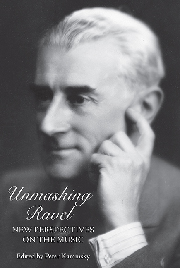Book contents
- Frontmatter
- Dedication
- Contents
- Acknowledgments
- Introduction
- Part One Orientations and Influences
- 1 Ravel's Poetics: Literary Currents, Classical Takes
- 2 Re-presenting Ravel: Artificiality and the Aesthetic of Imposture
- 3 Adorno's Ravel
- Part Two Analytical Case Studies
- Part Three Interdisciplinary Perspectives
- List of Contributors
- Index
2 - Re-presenting Ravel: Artificiality and the Aesthetic of Imposture
from Part One - Orientations and Influences
Published online by Cambridge University Press: 05 September 2013
- Frontmatter
- Dedication
- Contents
- Acknowledgments
- Introduction
- Part One Orientations and Influences
- 1 Ravel's Poetics: Literary Currents, Classical Takes
- 2 Re-presenting Ravel: Artificiality and the Aesthetic of Imposture
- 3 Adorno's Ravel
- Part Two Analytical Case Studies
- Part Three Interdisciplinary Perspectives
- List of Contributors
- Index
Summary
Maurice Ravel as artist and man has always intrigued the critics because he slides from their grasp, eludes the intellectual analyst as he does the writer of romantic biographies.
Alexis Roland-Manuel, Maurice RavelRoland-Manuel's words capture something of the elusiveness of Ravel's legacy. This chapter assesses individuals and groups close to Ravel who had an important role in shaping his aesthetic and the public understanding of his music. The central figure in this process was Roland-Manuel—Ravel's student, disciple, spokesman, and friend. Roland-Manuel is frequently cited as his first biographer, but his role in influencing and writing Ravel's legacy has not been scrutinized. Roland-Manuel's efforts to relaunch the composer in pre-and postwar France amounted to an important, if subtle, repackaging of Ravel in the context of shifting postwar aesthetics. This study traces the emergence of a discourse of artificiality and the “aesthetics of imposture”; while Roland-Manuel identified a separation between the composer and his work, he also made links between musical qualities and personal characteristics. Besides Roland-Manuel, Calvocoressi, a member of Les Apaches, was the first to write about artificiality in Ravel's music and personality, but he was also among the first to identify the dangers of defining Ravel too narrowly. Comparing Roland-Manuel's constructed image of Ravel with the composer's own writings on the purpose, process, and outcome of composition reveals Ravel's nuanced perspective on a composer's relation to his work, a position that neither excludes the creator nor regards the artwork as a reflection of the composer's character.
- Type
- Chapter
- Information
- Unmasking RavelNew Perspectives on the Music, pp. 41 - 62Publisher: Boydell & BrewerPrint publication year: 2011

